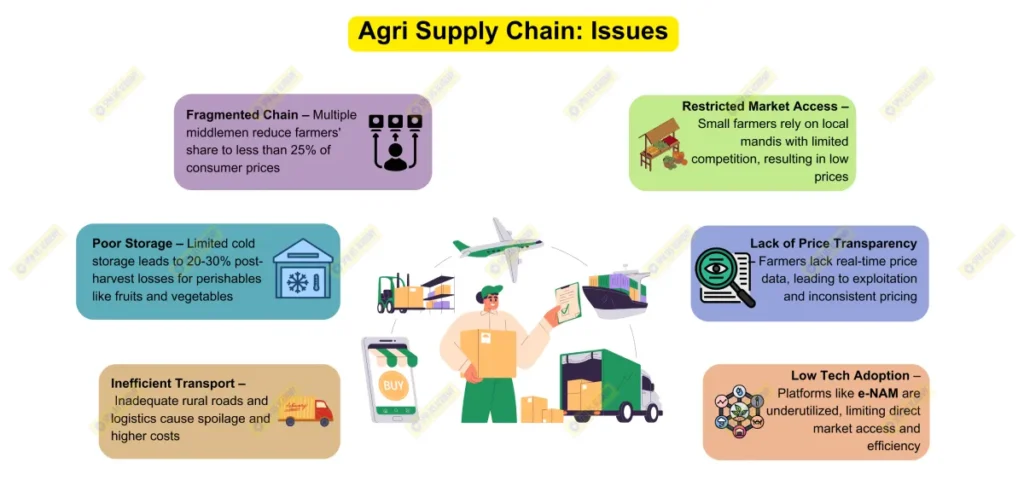The Supply Chain of Agricultural Produce encompasses the entire journey agricultural goods take from production on farms to their final delivery to consumers. This chain includes several critical stages: production, post-harvest handling, storage, transportation, processing, marketing, and distribution. Each stage involves various players, infrastructure, and transactions, all essential for moving produce efficiently and maintaining quality.
Key Stages in the Agricultural Supply Chain

- Production – This is the first link in the chain, involving farmers growing crops or raising livestock. Factors like seed quality, irrigation, fertilizers, and pest control influence output.
- Post-Harvest Handling – Once harvested, crops need sorting, cleaning, grading, and packaging to prevent spoilage and maintain quality for marketability. According to the Food Corporation of India (FCI), about 10% of grain crops can be lost during this stage due to inadequate handling.
- Storage – Proper storage is vital to avoid post-harvest losses, especially for perishables like fruits and vegetables. In India, a lack of cold storage facilities results in about 20-30% of perishable produce going to waste, as per NITI Aayog data.
- Transportation – Efficient logistics are critical for moving agricultural goods to markets. Poor rural road infrastructure and inadequate cold chain facilities lead to delays, increasing spoilage and costs.
- Processing and Value Addition – Processing raw agricultural products into finished or semi-finished goods (e.g., milling wheat into flour) adds value, extends shelf life, and increases market demand.
- Marketing and Distribution – The produce is then sold to wholesalers, retailers, and consumers, either directly or through intermediaries like mandis (markets). In India, the Agricultural Produce Market Committees (APMCs) regulate agricultural trade, often leading to price variations and inefficiencies.
The Supply Chain of Agricultural Produce refers to the entire journey agricultural products take from the farm to the consumer. It involves production, storage, transportation, processing, marketing, and distribution. In India, this chain is often lengthy and fragmented, with multiple intermediaries between farmers and consumers, leading to inefficiencies and losses that reduce farmers’ income and raise consumer prices.
Role of E-Technology in Transforming Agricultural Marketing
E-technology has the potential to streamline the agricultural supply chain and address key challenges such as information asymmetry, inefficient logistics, and inadequate market access. By integrating digital tools and platforms, e-technology can empower farmers, reduce post-harvest losses, and make agricultural marketing more transparent and efficient.
A. Direct Market Access for Farmers
- E-technology platforms like e-NAM (National Agriculture Market) connect farmers directly with buyers across India, bypassing middlemen and enabling better price discovery. Since its inception in 2016, e-NAM has connected over 1.73 crore farmers and 2,500+ mandis across the country.
- Shanta Kumar Committee (2015) highlighted the need for reducing intermediaries in the supply chain to ensure fair prices for farmers. E-NAM and similar platforms align with these recommendations by creating a national digital market for agricultural produce.
B. Improved Price Transparency and Information Access
- E-technology provides real-time information on market prices, weather updates, and demand trends, enabling farmers to make informed selling decisions. For example, apps like Kisan Suvidha and Agmarknet offer instant access to mandi prices and market data, bridging the information gap.
- According to the Ashok Dalwai Committee on Doubling Farmers’ Income, transparency in market prices can help farmers decide the best time and place to sell, ultimately increasing their income potential.
C. Reduction in Post-Harvest Losses
- Around 15-20% of India’s fruits and vegetables are lost post-harvest due to lack of efficient logistics and storage, according to NITI Aayog. E-technology can integrate logistics, allowing for optimized transportation and better storage management. Platforms like NinjaCart connect farmers to retailers directly, ensuring produce reaches markets faster, reducing spoilage.
D. Digital Payment Solutions
- E-technology enables secure, instant digital payments, providing a safer and more transparent alternative to cash transactions. Platforms such as Unified Payments Interface (UPI) facilitate immediate payments, which ensures that farmers receive timely compensation, fostering trust and reliability in the system.
E. Access to Financial Services and Insurance
- Digital platforms enable farmers to access credit, crop insurance, and loan facilities directly through e-banking and fintech apps. For instance, PM-KISAN and M-Kisan platforms offer direct benefit transfers to farmers, ensuring support during crop cycles. NABARD reports indicate that financial inclusion through technology reduces farmers’ dependence on informal credit and mitigates risks.
E-technology in agricultural marketing holds transformative potential for India. By bridging gaps, reducing inefficiencies, and empowering farmers, digital tools can help achieve fair prices, reduce waste, and make India’s agricultural supply chain more resilient. This approach will not only support farmers but also make affordable, fresh produce more accessible to consumers, fostering a win-win situation for both ends of the supply chain











